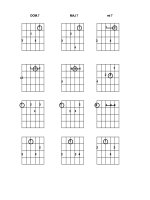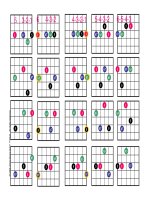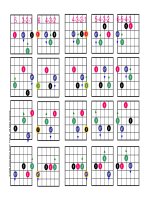05 tủ tài liệu bách khoa
Bạn đang xem bản rút gọn của tài liệu. Xem và tải ngay bản đầy đủ của tài liệu tại đây (191.25 KB, 14 trang )
Skill-Based Intensive Listening and Speaking Training
for TOEIC® A Preparation Course Based on
Underlying Theories and Instructional Principles
Tomoyuki Miyamoto
Abstract
In general, preparation courses for the TOEIC® test are conducted in such a way that
an instructors get the students to work on sample questions on preparation texts. However,
this instruction style does not necessarily meet the needs of the students. While gaining
higher scores on the test is clearly one of their major learning objectives, there are quite a
few students who wish to enhance their overall English proficiency, in particular, listening
and speaking skills by taking the course. This paper dwells on the skill-based listening and
speaking training and its effect based upon underlying theories and instructional principles
conducted for the students of the TOEIC® A preparation class of Open College Course held by
Osaka Jogakuin College in the spring of 2007.
Key words : TOEIC®, skill-based training, theoretical underlying, instructional principles,
intensive listening
Received September 26, 2007
TOEIC®
TOEIC®
TOEIC® A
TOEIC®
2007
1 . Introduction
The TOEIC A preparation course is one of the “open college” courses provided by Osaka
Jogakuin College (OJC) which is open to the public targeted for the learners of English who
already possess TOEIC B level scores (730 to 860 points) but have yet to reach TOEIC A
level (>860 points). The TOEIC B level learners can be defined as those who have the ability
to communicate with success in various situations where they have some expertise, but their
vocabulary and grammar may not always be the best choice or completely accurate (Gilfert,
1996). As an instructor who has been teaching at the aforementioned course, such criteria
seem to be reasonable. Observing the participants of the TOEIC A preparation course in
the past, the author had found that they had a relatively good command of English, a pretty
good range of vocabulary and grammatical knowledge. Still, they tended to have difficulty
in comprehending complicated discourses, catching up with natural English speed, and
engaging in discussions or conversations on a wider range of topics.
The TOEIC A preparation course for Spring 2007 was held from March 2007 to July 2007
that consisted of 12 classes (90 minutes per class). Usually, TOEIC preparation classes in
general are performed in such a way that instructors get students to work on sample questions
on TOEIC preparation texts. However, the results of the questionnaire conducted prior to
the course suggested that just working on preparation texts would not necessarily meet the
students’ needs. Gaining higher scores on the TOEIC test was certainly one of their learning
objectives; however, most of the students wish to enhance their overall listening and speaking
skills and to increase their vocabulary as well.
By looking into the needs of the students for details, the author found that the students’
language needs could be categorized into the following:
-Increasing accuracy and fluency in listening to grasp the core meaning as well as
detailed information on spoken texts
-Speaking English with confidence and maintained conversation for extended periods
of time
-Increasing vocabulary, in particular, on business-related topics
Taking into account these needs of the participants and the limited timeframe of the
course, the TOEIC A preparation course was designed to enhance the language skills related
to the aforementioned skill areas with particular focuses on intensive listening and speaking,
through skill-based training or activities based upon underlying theories and instructional
principles.
This paper dwells upon the skill-based training and activities incorporated into the three-
Miyamoto : Skill-Based Intensive Listening and Speaking Training for TOEIC® A Preparation Course Based on Underlying Theories and Instructional Principles
month TOEIC® A preparation course, which resulted in drawing good attention from the
students, some of whom have sensed an improvement in the focused language skill areas and
have gained higher scores in the TOEIC® test they took after the course. Especially, the post
survey has suggested that they felt some improvement in listening for details.
2 . Underlying Theories and Ideas
When language teachers introduce certain activities into the classroom, it is desirable
that such activities are based upon some form of theories or empirical evidence supported
by research findings. Given the nature of language acquisition processes, there is no solid
consensus as to what particular theories are universally accepted. Having said that, it is
necessary for the teacher to explain to the students why a certain activity has to be presented
to them based upon the cause-effect relationship of the skills to be incorporated. In the
course, in the light of the needs of the students as mentioned above, the author included
some of the theoretical underpinnings or ideas in introducing listening and speaking
activities.
2. 1 Speech Recognition and Information Processing
As far as listening is concerned, the claims often made by high-intermediate to lowadvanced English learners are that they can grasp the global meaning of the listening texts
but cannot grasp the details of the message, which results in misunderstanding. In other
words, misunderstanding or non-understanding of words in speech, whether through faulty
identification of word boundaries or insufficient knowledge of word meaning, is the major
source of confusion in language comprehension. Recognizing speech requires for a listener
to have the knowledge of prototypical sounds and sensitization to the sound variations of
those prototypes that are brought about through co-articulation process of assimilation,
reduction and elision (Rost, 2002). Therefore, in order to manage speech in real time, it is
crucial that the listener quickly separates the speech into a small number of constituents that
can be worked within short-term memory.
Furthermore, enhancing the speed of information processing may result in increasing
fluency or automatization in listening. Cognitive psychologists working in an information
processing model of human learning and performance see second language acquisition as
the building up of knowledge systems that can eventually be called on automatically for
understanding and speaking. Although learners have to pay attention to any aspect of the
language that they are trying to understand or produce, gradually learners become able to
utilize certain parts of their knowledge so quickly and automatically that they are not even
aware that they are doing it through practice and experience (Lightbown and Spada, 1999;
Mclaughlin, 1987).
2007
2. 2 Interaction
Many researchers have suggested that interaction among learners played a vital role
to enhance language learning in terms of both input and output (Hatch, 1992; Pica, 1994;
Long, 1983). Those interactionists emphasize the necessity for learners to have access to
meaningful and comprehensible input through conversational interaction with teachers and
other students. Long suggests that modified interaction is the necessary mechanism to make
language input comprehensible for learners (Long, 1983). They also argue that when learners
are given the opportunity to engage in meaningful activities, they are forced to ‘negotiate for
meaning’, that is to express and clarify their intentions, thoughts, opinions, etc., which would
lead them to arrive at a mutual understanding. This is especially true when the learners
are working together to accomplish a particular goal, for example in task-based instruction,
through which negotiation for meaning is accomplished through a variety of modifications
which naturally arise in interaction as learners will ask each other for clarification,
confirmation, repetition, and other kinds of information as they try to negotiate meaning
(Lightbown and Spada, 1999). Also, according to the research conducted by Porter (Long
and Porter, 1985) in which the language produced by adult learners performing a task in pairs
was valued, learners talked more with other learners than they did with native speakers, and
intermediate-level learners did not make any more errors with another intermediate-level
speaker than they did with advanced or native speakers. As a result, Porter concluded that
although learners cannot always provide each other with the accurate grammatical input,
they can be involved in genuine communicative practice which includes negotiation for
meaning, which is essential for language acquisition. The author also believes that interaction
can encourage the students to get involved in exercises, as it increases the students sense
of ownership in the exercise when they work in pairs, which should make the students
concentrate on the exercises.
In the meantime, the Uncertainty Management Theory proposed by Gudykunst (1995)
suggests that initial uncertainty and anxiety about another’s attitudes and feeling in a
conversation are the basic factors affecting communication. That is, uncertainty prevents
learners from engaging in effective communication. Interaction between the students, not
between the teacher and the students, may reduce uncertainty or fear that can be raised
when a learner has a conversation with a more advanced learner or a native speaker.
2. 3 Building up Schema and Vocabulary
Learners of English often cite the lack of background knowledge or vocabulary as the
reason for misunderstanding. Clearly, limited vocabulary is one of the crucial factors of
miscomprehension. Thus, it is important for the learners to try to increase vocabulary and
Miyamoto : Skill-Based Intensive Listening and Speaking Training for TOEIC® A Preparation Course Based on Underlying Theories and Instructional Principles
schema. Understanding what a speaker says is greatly related to shared concepts and shared
ways of reacting to the world. In virtually every listening situation, calling on knowledge
from stored prototypes and universals is absolutely crucial to comprehension. When this
knowledge is activated during comprehension, additional information, stored as related
schemas, becomes available to the listener (Rost, 2002).
3 . Instructional Principles
3. 1 Authenticity
To be capable of processing naturally spoken language fluently, it is necessary for the
students to be exposed to authentic materials; therefore authenticity of the materials used
is an important element. Rost (2002) suggests that language input should aim for ‘user
authenticity’, first, by aiming to be appropriate to the current needs of the learners, and
second, by reflecting real use of language in their real lives. In other words, language input
should be ‘genuine’, i.e. involving features of naturally occurring language with and between
native speakers: speed, rhythm, intonation, pausing, idea, density, etc. However, it is usually
difficult for the learners to follow the speed of naturally spoken English. In the course, various
types of listening materials were used that included news reports, interviews, lectures spoken
at natural speed. But some of the difficult materials in terms of speed were used in such a
way that the sentences were chunked into manageable segments for the students.
3. 2 Maintain Concentration
As intensive listening attends to precise sounds, words, phrases, grammatical units as well
as pragmatic units, it requires for the learners to concentrate on listening so they can catch
those factors. As exemplified in the sample activities below, such skill training as shadowing,
dictation, and reproduction of the heard speech require for the students to maintain high
level of concentration, because if the students fail to concentrate enough, they would fail to
perform those tasks.
3. 3 Genre Focused
One of the best means to expand one’s schema and vocabulary is to limit the genre of
the texts or discourses that learners are exposed to. As TOEIC® mainly deals with business
related topics, using materials or articles pertaining to business and economy should motivate
the students because they are clearly relevant to them. As Sperber and Wilson suggest
(1986), it certainly makes sense to place relevance of input as the top priority in teaching.
Also, vocabulary quizzes performed every week gave the students opportunities to learn on
vocabulary explicitly, and such vocabulary is frequently appeared on the other materials used
in other skill activities, the students came across such high-frequency vocabulary many times.
2007
3. 4 Make Tasks Interactive
As the interactionists suggest, interaction among students will increase the amount of
input as well as forced output compared with a teacher-centered instruction, so as another
instructional principle, the author tried to incorporate various interactive activities among the
students that include paraphrasing/summarization of the heard speech between pairs, the
Comprehension Check and the Outline exercises that are explained in the sample activities
below.
4 . Course Rationales
The course consisted of five adult students. By analyzing the survey conducted prior to
the course, it was found that the needs of the students were summarized into the following
three major categories: 1) increasing accuracy and fluency in listening to grasps the core
meaning as well as detailed information of the speech, 2) speaking English with confidence
and maintained conversation for extended periods of time, and 3) increasing vocabulary, in
particular, on business-related topics.
Based upon the students’ needs, the overall course objectives were set as “through
intensive listening, speaking and vocabulary training, the students will be able to improve
their English proficiency to the level close to TOEIC® A scorers with sufficient communication
skills as a non-native speaker”. Additionally, the following practical objectives were presented
to the students: 1) Through the series of listening, speaking and reading training, the students
will be able to gain higher scores after the course, 2) the students will be able to increase
business vocabulary by expanding their schema through skill training on business related
topics, 3) the students will be able to handle naturally spoken English and to comprehend the
meaning in depth.
5 . Course Content and Skill Areas Covered
The skills explored in the course were intensive listening through shadowing, dictation,
comprehension check, reproduction, and summarization/paraphrasing. To increase
vocabulary, a vocabulary quiz was performed at each class. The words selected for the quiz
were chosen from business news transcripts used for listening training. In order to check
the advancement of the students’ vocabulary level, pretest and posttest on the business
vocabulary were performed. As speaking training (and as listening training as well),
shadowing, reproduction with note-taking (individual, pair or group work), and the Outline
exercise (presenting the summary of the reading at home to the class) were incorporated.
Moreover, in order for the students to quickly cope with the questions on the TOEIC® test,
timed-reading exercises, and chunk-based reading exercises were also conducted at each
Miyamoto : Skill-Based Intensive Listening and Speaking Training for TOEIC® A Preparation Course Based on Underlying Theories and Instructional Principles
classroom time.
In the course, skill areas covered were listening (40%), speaking (20%), writing (10%),
vocabulary (10%), and reading (20%). However, given the nature of the skill training, there
were some overlap; in other words, such training as shadowing, reproduction, and the Outline
exercise can be viewed as listening as well as speaking training. Furthermore, as shadowing
requires for students to pay attention to the words of the heard sentences, it can lead to the
incidental learning of vocabulary. With regard to grammar, as the students had already
learned on the basic grammar items dealt in the TOEIC® test, it was taught by consciousnessraising through various skill training.
In the Outline exercise, the students were asked to pick up and read a book or at least a
lengthy article of their interest every two weeks outside of the class (reading phase), and to
write the summary and comment of their reading on one to two page paper (writing phase).
Then, in the class, the students were asked to write the outlines and opinion on the worksheet,
based upon which the class formed a pair or a group to discuss their reading (speaking).
Therefore, this training also can be regarded as a mixed exercise on reading, writing, listening
and speaking: the overlapping of skills.
Concerning the topics in the classroom, as the TOEIC® test deals mainly in business and
economic issues, these areas were mainly covered. First of all, the author chose relatively
easy news on economy or business in terms of its vocabulary level and speed. Also, the
reproduction exercise was initiated on a phrase level without note-taking, then increased the
difficulty onto sentence level (without note-taking), and paragraph level with note-taking, so
that the students’ load should be increased on a step by step basis. Also, on the latter half
of the course, lectures conducted by native and non-native speakers were used as listening
materials in order for the students to expose to various types of discourse.
As the means for instruction, the exercises were introduced to the students by giving
individual tasks, pair and/or group work. As mentioned above, The Outline required for
students to submit at least 2 page of writing so that they could have tangible outcomes.
6 . Sample Activities
Here are five sample activities chosen from the skill-based training and/or activities
conducted in the classroom as mentioned above.
2007
Activity 1: Shadowing
Skill Areas covered: intensive listening, speaking, vocabulary
Related theories or principles: information processing, concentration, authenticity
Procedure:
-The teacher has the students listen to news or speech played by a tape-recorder.
-The teacher demonstrates how to shadow (imitate and repeat, in a few seconds,
sentences)
-The teacher gets the students to do shadowing (twice).
-The teacher distributes the transcript of the speech to the students so that they could
check the sentences to confirm which parts they were able to follow or not.
-The teacher gets the students to do shadowing after the content of the speech has
been understood by the students.
-The original speech is recorded onto the cassette tapes of the students so they can
practice it at home.
Activity 2: Dictation
Skill areas covered: intensive listening, vocabulary
Related theories or principles: information processing, authenticity, concentration
Procedure:
-The teacher distributes a sheet of paper that contains sentences with some of the parts
are closed out.
-The teacher plays speech and asks the students to fill out the brackets (missing parts).
-The teacher plays the speech once again chunk by chunk
-The teacher plays the speech once again from the start.
-The teacher distributes the transcripts so that the students can check their answers.
-The teacher plays the speech once again for final check.
Activity 3: Comprehension Check
Skill areas covered: intensive listening
Related theories or principles: information processing, concentration, interaction
Procedure:
-The teacher distributes a sheet of paper that contains a couple of questions on the
main idea of the source text with blanked spaces.
-The students are paired up.
-The teacher plays a tape to have the students to listen to the text.
-The teacher stops the tape and asks the students to write the answers to the questions.
-The students compare their answers with the partner and discuss them.
Miyamoto : Skill-Based Intensive Listening and Speaking Training for TOEIC® A Preparation Course Based on Underlying Theories and Instructional Principles
-The teacher plays a tape again.
-The students discuss their answers with the partner once again.
-Each pair is asked to present their answers to the class.
-The teacher plays the tape again and explain the content.
Activity 4: Reproduction with/without note-taking
Skill Areas covered: intensive listening, speaking, vocabulary
Related theories or principles: information processing, concentration, interaction
Procedure:
-The teacher gets the students to listen to the entire text for comprehending the global
meaning of the text.
-The teacher plays the tape again, stops the speech by chunks and asks the students to
repeat what they have listened by chunks. The students can not take notes.
-The teacher plays the tape again, stops the speech by sentences and asks the students
to repeat what they have listened by sentences. The students can not take notes.
-The teacher plays the tape once again from the start, stops the speech by paragraphs.
The students are asked to reproduce the original paragraph. This is done either
individually or in a pair. The students may take notes.
Activity 5: the Outline
Skill areas covered: reading, listening, speaking, writing
Related theories or principles: interaction
Procedure:
-The students are asked to choose one book or one lengthy article to read. Each
student needs to read the book or the article in two weeks then to write the summary
and comment on what they have read on paper (two-pages at the longest).
-In the class, the teacher distributes a sheet of paper entitled
“The Outline”, and the
students are asked to write down the outline of their written paper in five minutes.
-The students are paired up or form a group.
-Each student presents based upon the Outline sheet. The partner may ask questions
for clarification.
-The teacher asks the students to switch the partner.
-If time is left, the group will present what they have listened to the class.
2007
7 . Conclusion
After the three-month intensive course, the author undertook the posttest on the business
vocabulary and a post survey to see if the course would meet the needs of the students (see
Appendix). All of the students have responded that they believe they have stretched out
their ability to close to the level they wished to achieve. In particular, such materials and
skill based training and/or activities as Business News with Vocabulary Quizzes, Summary
(English to English), Reproduction practice, and Sight Translation were found to be useful for
the majority of the participants (Table 1). Looking at the comments of the students for openended question in the survey (question 5), some of them have responded that they have been
able to listen to the details of a speech including prepositions more accurately than before as
a result of the intensive listening training and to improve their speaking by taking on summary
exercises and/or activities with the Outline. Moreover, with regard to the overall content and
management of the course, the participants looked quite satisfactory according to the result
of the survey (Table 2).
Furthermore, an increase was found in the score of the posttest on business vocabulary.
30 business words and phrases (total 30 score) were chosen that were equally appeared
on both pretest and posttest. While the average score for the pretest was 7.8 (26%), it was
increased to 13.4 (45%) in the posttest. As these words were picked up from the materials
used for the exercises, the students had been exposed to the words in listening, reading
activities, aimed at incidental learning of the words. Also, as vocabulary quiz was conducted
in every class, the students were continuously and explicitly exposed to the vocabulary,
which might lead to the acquisition of the words as well.
Of the five students who participated in the course, two of them reported that they could
achieve higher scores in the TOEIC® test they took shortly after the course with the averaged
scores of 825 points from 750 points (a 75 points increase). Given the size of the students, this
does not necessarily suggest that the effect of the training has been reflected on the increase
in their scores. Also, this paper is not intended for presenting quantitative evidence of the
effect of the skill training and/or activities applied in the course. That said, they have reported
that they become more focused on listening and listening for more details during the test. In
order to measure the effectiveness of the skill based training and/or activities of the course, it
should be necessary to design a larger-scale, long-term quantitative research, which requires
for participants to take the TOEIC® test shortly before and after the course for more accurate
comparison.
Miyamoto : Skill-Based Intensive Listening and Speaking Training for TOEIC® A Preparation Course Based on Underlying Theories and Instructional Principles
< Table 1.> Result of the Question 2 of the Survey: “What materials and/or teaching methods
did you find useful? Please choose any from the following.”
Materials and Methods
The number responded “Yes”
Occupancy ratio
Course textbook
1
20 %
Business news with vocabulary quizzes
5
100 %
Summary (English to Japanese)
2
40 %
Summary (English to English)
3
60 %
The Outline & discussion
2
40 %
Reading and writing task
2
40 %
Shadowing
2
40 %
Reproduction (Retention) practice
5
100 %
Sight Translation
4
80 %
Comprehension Check
2
40 %
Other materials and methods
0
0 %
Items
Average points
a. Level of the text and materials
9.6
b. Degree of your interest in the text and materials
9
c. Pace of the instruction
9.6
d. Easy-to-understand instruction
9.8
2007
<Appendix> TOEIC A Preparation Course Post Survey: Questionnaire for the Students
Please respond to the following questions. Feel free to write your comment for the “Open”
questions
1.
Do you think you have achieved your objectives set up prior to the course? (Open)
2.
What materials and/or teaching methods did you find useful?
Please choose any from the following:
-Course textbook
-Business news with vocabulary quizzes
-Reading and writing task
-Summary (English to Japanese)
-Summary (English to English)
-The Outline & discussion
-Shadowing
-Retention practice
-Sight Translation
-Comprehension Check
-Other materials and methods
3.
On average, how many hours did you spend in preparing for the class per week? (Open)
4.
Please evaluate the content of the course. (from 10 “Very Satisfied” to 1 “Dissatisfied”)
a. Level of the text and materials
10 9 8 7 6 5 4 3 2 1
b. Degree of your interest in the text and materials
10 9 8 7 6 5 4 3 2 1
c. Pace of the instruction
10 9 8 7 6 5 4 3 2 1
d. Easy-to-understand instruction
10 9 8 7 6 5 4 3 2 1
5.
What skill areas do you think you have made an improvement by taking the course? (Open)
6.
Please write any comment for further improvement for the course. (Open)
Miyamoto : Skill-Based Intensive Listening and Speaking Training for TOEIC® A Preparation Course Based on Underlying Theories and Instructional Principles
References
Gilfert, Susan.(1996). A review of TOEIC, The Internet TESL Journal, 2(8). Retrieved from />Articles/Gilfert-TOEIC.html on May 1, 2006.
Gudykunst, W.(1995). The uncertainty reduction and anxiety-uncertainty reduction theories of Berger,
Gudykunst, and associates. In D. Cushman and Kovacic (eds), Watershed research traditional in
human communication theory. New York: NYU Press.
Hatch, E.(1992). Discourse and Language Education. Cambridge: Cambridge University Press.
Lightbown, P. and Spada, N.(1999). How Languages are learned. Oxford: Oxford University Press.
Long, M.H.(1983). Native speaker/non-native speaker conversation and the negotiation of comprehensible
input. Applied Linguistics 4: 126-41.
Long, M.H. and P. Porter.(1985). Group work, interlanguage talk, and second language acquisition. TESOL
Quarterly 19/2:207-28.
Mclaughlin, B.(1987). Theories of Second Language Learning. London: Edward Arnold.
Pica, T.(1994). Research on negotiation: What does it reveal about second language acquisition?
Language Learning 44:493-527.
Rost, M. (2002). Teaching and Researching Listening. Harlow, UK: Pearson Education.
Sperber, D., and Wilson, D. (1986). Relevance: communication and cognition. Oxford: Basil Blackwell.









